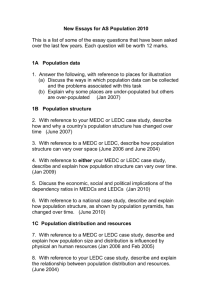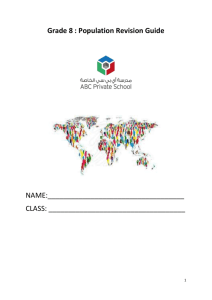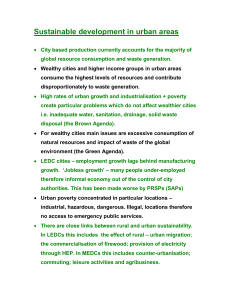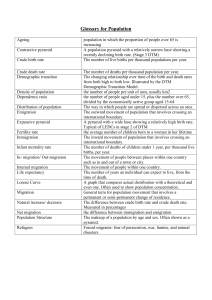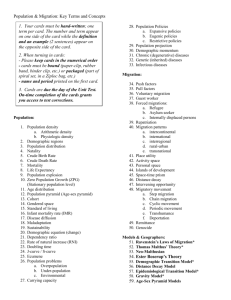Population Revision
advertisement
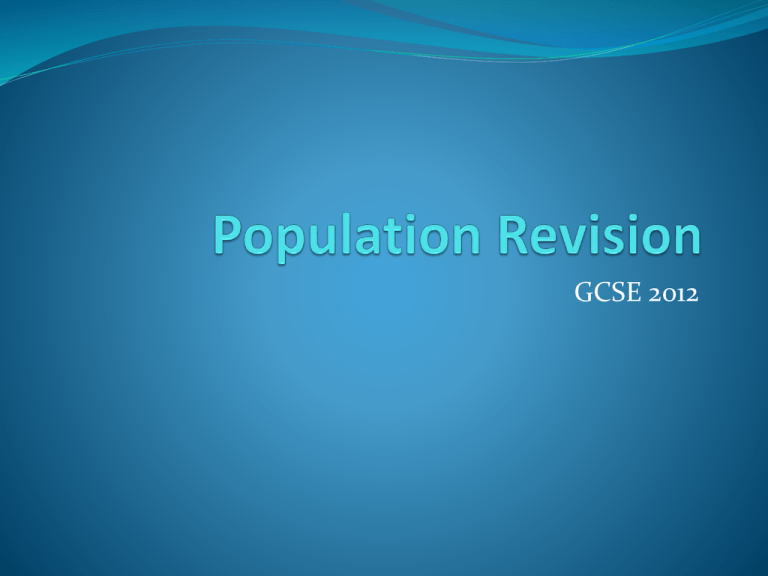
GCSE 2012 This will be the st 1 question on the exam In my opinion this may be the easier section You should still revise the other section- settlement Use the table to sort your revision for this section 3 case studies we must have:- 1- A case study to illustrate strategies to influence natural population change within a country. 2- A case study of international migration to illustrate the causes, consequences and management. 3- A case study of migration within one country. Content Theme 2 Population and Settlement Sources of info Revised? page revised Study of contrasting population pyramids of RG p29-30 an LEDC and an MEDC and how they change over time. The relationship between population RG p28 structure (and birth rates and death rates) and economic development. The growth of population on a global scale. RG p28 Birth rates and death rates vary between RG p30 countries. The rate of population change varies over RG p28 time. The effects of overpopulation in an LEDC. RG p32 The implications of the proportion population in different age groups. of RG p33-34 Push and pull factors influencing migration. RG p35 Causes, consequences and management of RG p39-41 urbanisation. Causes, consequences and management of RG p42 What do you need to know? How and why are there variations between the population structures of countries? What are the causes and consequences of natural population change over time? Why does migration occur and what are its effects? content Countries have individual age and gender profiles. Population structure varies between countries of different levels of economic development. The population structure of individual countries changes over time. What has happened to Earth’s population? World growth- key points Has been steady till 11th century Slow growth till 1500 Real growth from Asia China / India have roughly 1/3 of world population What are the consequences? World population to reach 7 billion in October 2011 How does population change? Birth rate- number of live babies born per 1000 of the population per year Death rate- number of deaths per 1000 of the population per year Natural increase of a countries population is when Birth rate > death rate Natural decrease of a countries population is when death rate > birth rate Life and death What do we mean when we talk about birth and death rates? The number of babies being born in a country each year is the birth rate. The number of people who die in a country each year is the death rate. These rates are measured for each 1000 of the population. A country’s birth rate is 10. This means that 10 people are born for every 1000 of the population per year. If the country’s population was 10,000 then there would be 100 extra people in the country after one year. Natural increase The data from the birth and death rates can be used to work out the natural increase in a country’s population. Natural Increase = Birth rate - Death rate If it is a positive number, the country’s population is increasing. If it is a negative number, the country’s population is decreasing. High birth rates combined with longer life expectancy have contributed towards the world population explosion. What will happen to the population when………………………..???????? Heads Tails High birth rate High death rate High birth rate Low death rate Low birth rate Low death rate Low birth rate High death rate Low birth rate Medium Death rate Medium Birth rate High Death rate Medium Birth rate Low Death rate Results- grows fast/ grows slowly/stable / decreases Study of contrasting population pyramids of an LEDC and an MEDC and how they change over time As countries become more developed, birth and death rates change Countries move through the Demographic Transition Model Life expectancy increases with development MEDCs and LEDCs The level of development of the country can impact on how quickly its population is rising. Countries with a lot of money are called More Economically Developed Countries (MEDCs). Countries with less money are called Less Economically Developed Countries (LEDCs). Transitional countries are states which are becoming more economically developed. What is a population pyramid? The elderly dependentspeople who are reliant on the younger economically active The young dependentschildren aged between 0-15 rely on 16-64 to provide for them Population structure MEDCs and LEDCs usually have differently structured populations due to differences in their birth and death rates. The population structure of a country is usually drawn on a graph called a population pyramid. This shows the total population of males and females in different age ranges. How would you describe the structure of this population pyramid? A LEDC High death rate High Birth rate High number of young dependents CharacteristicsBroad base- indicating a high birth rate Narrows towards its peak religious opposition to birth control etc. lack of education on family planning/birth control No / little use of contraception early marriage Many babies die Children seen as sign of virility • importance attached to large families/ Poor healthcare Why a high birth rate? children look Women’s role? after family members who • low status of women/denied are old/ill right to decide on having children/poor education of women • government policies regarding birth control • children used as workforce/seen as economic asset Poor hygiene- no piped, clean water and no sewage disposal Disease famine Why a high death rate? Little medical sciencefew doctors, hospitals or drugs A MEDC Characteristics Broad pyramid for all age groupsGrowing size at peak Increasing size of elderly Narrowing base as Birth rate declines Why does the death rate fall? • improved medical care/hospitals/vaccinations • improved water supply/sewage disposal/sanitation • diet/food supply- machines – fertilisers /farming • improved housing/standard of living/jobs • education about hygiene/contraception/STD/jobs/nutrition. Why does the birth rate fall? • family planning •Lower infant mortality rate- less need for children • adults pursuing profession •Increased industrialisation and mechanisation- less need for workers •Increased desire for material possessions- house /cars / holidays •Emancipation of women as workers with careers issues with population change Overpopulation Controlling a population Ageing populations overpopulation Is when there are too many people for the resources that the country has available- the optimum population has been exceeded Normally caused by RAPID population growth Symptoms of overpopulation include- widespread poverty, food shortages, unemployment Normally an issue for LEDCs- Bangladesh Effects of overpopulation- rural Not enough schools Not enough land Overgrasing / over-cultivation Deforestation Food shortages Lack of clean water and sanitation Inadequate health services Effects of overpopulation - cities Overcrowding Growth of shanty houses Traffic congestion Overcrowded schools Inadequate health services Problems of waste disposal Unemployment Under employment Children forced to work How is overpopulation controlled? China- birth control programme Immigration laws- selective as to who can come in Problems- ageing population, kidnaps, top heavy pyramid China – one child policy Aim – to reduce the birth rate 1 child- 2 in rural areas if 1st was a girl or if both parents are only children Benefits- free education- university place, free healthcare forced abortions and sterilisation educate women so that they can have a career guaranteed jobs if only single child in family loss of benefits/fines for subsequent children; etc. constant advertisements on TV and in the Press about the benefits of having only one child ‘granny police’ who advised authorities if a second child was born; etc. Ageing populations Most MEDCs are facing this problem More and more people are living longer Life expectancy continues to increase Impact of ageing population Healthcare stretched Unpaid carers? Later retirement Smaller pensions The grey vote- winter fuel bills, tv licence, bus passes Care homes Meals on wheels People paying increased taxes to pay for state pensions & healthcare People having to retire later- >65 Relaxed immigration to fill void and inject workers into economically active sector recap Yes uI can describe the factors affecting population density. uI can describe the increase in overall world population, and how it divides up between MEDCs and LEDCs (with examples). uI can explain (and draw) the demographic transition model. uI can read and explain population pyramids. uI can explain why population growth or decline needs to be managed uI can explain why and how China managed their population with the “one child policy”. I can also explain the effects. uI can describe four types of migration. uI can explain push and pull factors for migration (both international and internal). uI can explain how migration affects the UK. uI can use the example of African migration to explain the impacts of migration on the host and donor regions. uI can use the example of the UK to explain the issue of population change in MEDCs. Think so No

